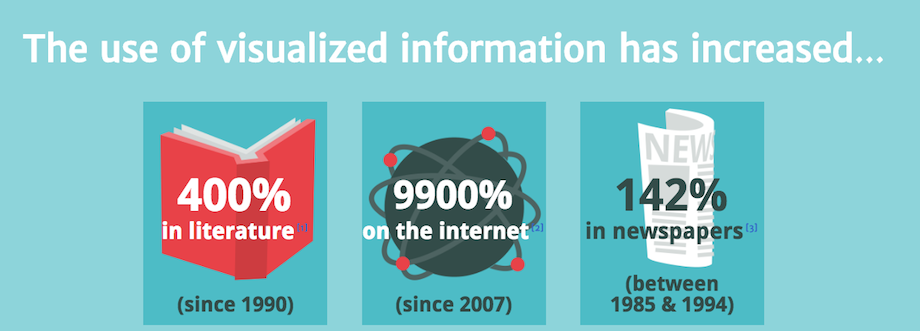By Keely Smith, Design & Multimedia Specialist
Check out our other similar blog posts below:
How Infographics Work and Why Your Brand Needs to Use Them More
By Keely Smith, Design & Multimedia Specialist
Check out our other similar blog posts below:
How Infographics Work and Why Your Brand Needs to Use Them More
 By Chance Shay, Communications Strategist
By Chance Shay, Communications Strategist
In 2015 it’s impossible to browse a news site, scroll through your social media stream or learn about an innovative product without coming across an infographic and there’s good reason for that.
Humans are consuming more information than ever before. In fact, in 2008 Americans consumed about 1.3 trillion hours of information outside of work. This works out to an average of nearly 12 hours per person per day, which means most American’s are constantly consuming information other than when they sleep.
With so much information coming at a person each day, how does a brand communicate in a way that gives itself the best chance at having its information capture the attention of current and prospective customers?
In addition to allowing information to be consumed easier, infographics lend themselves perfectly to the modern culture of social sharing. The cool designs, fun visuals and interesting kernels of data make infographics the perfect content to share with Twitter followers, muse about on YouTube channel,s up-vote on Reddit or even write a blog about (this blog about infographics being good for blogs = blogception).
But enough words, we’ll let the visuals do the talking. The good folks at NeoMam Studios put together an awesome interactive infographic webpage (we LOVE HTML5 too!) illustrating thirteen reasons why your brain craves infographics. Some of those images are below, but visit their webpage for the full list.
And remember the golden rule: if you can communicate your message visually, do it.
Check out our related posts below:
Solution-Based Web Tools For Every PR Pro
Your Competitive Advantage is Being Human
By Keely Smith, Design & Multimedia Specialist
Branding plays an influential role in setting a business up for success. A brand is more than just a logo – it is a visual representation of a business’ values and creates an entire customer experience from the visual identity and website to social media presence. So is yours working for you? Below are 5 signs your brand is due for a refresh.
Our world is certainly no stranger to change. With the adoption of new technologies, it is  important to have a brand that moves a business forward and doesn’t hold it back. Having a “retro” identity may be intentional in some cases. However, if a brand is no longer effectively serving as a visual representation of your business and its vision and doesn’t communicate key messaging clearly, it’s time for an update.
important to have a brand that moves a business forward and doesn’t hold it back. Having a “retro” identity may be intentional in some cases. However, if a brand is no longer effectively serving as a visual representation of your business and its vision and doesn’t communicate key messaging clearly, it’s time for an update.
A complete overhaul is not always the solution. Minor adjustments to existing elements, like a change in color palette or typefaces used, are very simple and effective ways to give your brand a facelift. The goal is to achieve an identity that looks timeless.
As a business grows, so should its brand. Let’s say a business changes its services offered – there has been a shift in target audience, or a new partnership has formed. A successful brand should reflect any modifications made. If the existing brand is no longer applicable to current growth and expansion, it’s time to go back and revisit the drawing board.
Are you an industry leader? Do you have outstanding customer service? Are you serious about what you do and what your business has to offer? Great! Your brand should represent everything you take pride in as a business.
A well-thought-out, well-designed brand can do wonders for paving the way to success. A brand creates a “visual reputation” and has a major influence on public perception. If you want your business to be taken seriously, you need to seriously invest in the development of your brand. It will set you apart from competitors and is a proactive way to add value to everything you do.
Do you have five or more logos? Countless ways your brand is being used? Consistency is everything, and having too many brands or different logo elements displayed across different media platforms (web, social media, printed collateral, etc.) may hinder the message your business wishes to communicate. Less really is more when it comes to a visual identity. Excessive taglines, colors, gradients and drop shadows in graphic elements are a thing of the past. We have seen a shift in design trends from the overly flashy to the minimal and simplistic.
Although versatility is not a necessity, it provides an opportunity to establish a strong and consistent visual presence. You may have a visual element or icon associated with your brand, which could be used to create a background pattern for a website, for example. You can have a dynamic branding suite, yet maintain consistency and market your brand effectively.
 There are countless platforms out there that allow anyone to create their own brand with the click of a button. Although this may be convenient and cost-effective, it runs the risk of projecting an unsuccessful or negative image. This is where investing in your brand pays off. It is important to work with a graphic designer when it comes to the development of your visual identity. Graphic design is an art form, and designers are constantly fine-tuning their skill. Designers specialize in visual communication and know how to deliver an intentional brand with a strong visual presence.
There are countless platforms out there that allow anyone to create their own brand with the click of a button. Although this may be convenient and cost-effective, it runs the risk of projecting an unsuccessful or negative image. This is where investing in your brand pays off. It is important to work with a graphic designer when it comes to the development of your visual identity. Graphic design is an art form, and designers are constantly fine-tuning their skill. Designers specialize in visual communication and know how to deliver an intentional brand with a strong visual presence.
It all goes back to what you are trying to accomplish as a brand. Consistency is critical, and your branding should reflect that. Whether you’re a big corporation or a small startup, these tips will help you decide if a refresh is right for you.
Everyone seems to have an opinion on the future of Google+. A quick Google search of “Google+ is dead” nets several articles debating the future of the social network. The headlines read:
In 2011, when I got an “invite” to join the new exclusive social network, I was excited about the possibilities. Would it replace Facebook as the social network du jour? Would Google finally launch a successful social media platform (RIP Google Buzz)? I was disappointed when, within a few short months, Google+ seemed to lose its luster.
Speculators have been hemming and hawing over Google+’s longevity since just after its launch, but those questions increased last month when Vic Gundotra, head of Google+ social efforts, announced that he was leaving the company. To add to the PR firestorm, Tech Crunch published an article citing a “source” that claims that “Google+ will no longer be considered a product, but a platform — essentially ending its competition with other social networks like Facebook and Twitter.” Google denied the claims.
(W)right On’s conclusion: Don’t delete your Google+ profiles yet. While the future of the social network isn’t clear, it still provides a number of benefits for brands:
SEO: Google is a search engine, so it makes sense that Google+ provides significant SEO advantages. Google+ content itself – meaning content you post to your page – can rank in search results in instances where your website may not. Google+ also allows for near-instant indexing, whereas simply putting up new content and waiting it out usually takes a few days.
According to Forbes, “linking your Google+ page to your content via Google Authorship markup will cause the headshot and stats from your Google+ profile to show up in Google’s search results pages next to content you have written. This includes a your profile picture displaying within search results next to your content, which has been shown to draw user’s eyes and significantly improve click-through rates.”
Further, when someone follows you on Google+, it is much more likely that your content will appear higher in their search results. And when other Google+ users give a link multiple +1s, the pages shoot up in the search rankings.
No Pay for Play: Facebook has more active users than Google+. But with the latest change to its algorithm, Facebook has recently become “pay for play,” which means it’s difficult for posts to gain traction unless the page owner pays money to “boost” them. This means that “free” Facebook marketing may no longer a viable way for businesses to reach consumers.
[RELATED: Pay for Play: Will Facebook Get In Trouble?]
Quality Visits: According to a recent report from Shareaholic, Google+ actually has the second highest social media post-click engagement. YouTube took the #1 spot and Facebook is down at #5. So although Google+ drives fewer referrals compared to its competitors, it turns out the traffic it does drive is actually quite high on the quality scale. Google+ users spend more than three minutes diving into links shared by their circles, view 2.45 pages during each visit, and bounce only 50.63 percent of the time.
For these reasons alone, we recommend that brands include Google+ as one part of a comprehensive social media strategy. What are your thoughts on Google+? Is it dead, alive or maybe just sick? Join the debate in the comments.

For a business, it is important to send the right message to your audience, but it is equally important that the audience can understand your message. After all, not everyone is an expert. Today, any individual can access the Internet and find very specific answers to very specific questions, but if their questions involve you or your message, how do you know that they’ll remember that information?
Information graphs or “infographs” are visual tools that communicate information simply and aesthetically. They take profuse and in-depth knowledge and present it clearly and concisely through visual representation. Infographs typically contain statistical information about a specific topic or field of work, but have also been adapted to communicate themes and ideas as well.
The value of infographics as a communication tool can be attributed to the way our brain processes information. For instance, right now you’re reading this article, line by line, taking in everything in the chronological order it was written. Because we read in a linear pattern, our brain cannot process information faster than we can supply it. The brain can process visual information up to 60,000 times faster than text, however. When you look at a picture of, let’s say a beach, every element of the photo is interpreted simultaneously, so you know the image is of a beach. Even when viewed separately, say separate images of palm trees, sand, or waves, you can infer that a beach is connected to these themes. However, after just describing a beach to you, you had to process that information linearly (e.g. palm trees -> sand -> waves = probably a beach).
Infographics are a valuable communication tool. When communicating with your audience, as a business or otherwise, an infograph brings a level of professionalism and expertise in a given topic through your ability to clearly convey complex data or information. Additionally, people want more visual content. In fact, there has been an 800 percent increase in “infographic” searches on Google throughout the past two years. The viral potential for visual content is at its highest. Who knows, maybe your next infographic could be your breakout in Internet immortality.